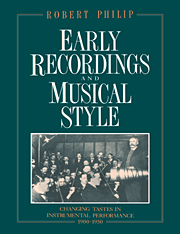Summary
INTRODUCTION
In the early part of the twentieth century, there was general agreement about the need for flexibility in performance, not only in overall tempo, but also in more detailed phrasing. The pianist Josef Lhevinne was expressing a widespread view when he wrote, 'Rhythm should not be thought of as something dead. It is live, vital, elastic.' The violinist Achille Rivarde similarly wrote,
Rhythm is elasticity of movement. In physical life when the arteries harden and lose their suppleness, old age sets in and the decrease of vitality begins, and in music the analogy holds good. When the natural rhythmic ebb and flow, the elastic give-and-take of movement is resisted, the performance is characterised by a certain lifelessness and affects the listener as being spiritless. This elasticity of movement, this rhythm should be felt in every bar.
This view was supported by both performers and composers. Elgar's demand for elasticity has already been quoted, and his own flexibility in rhythmic detail was commented on by contemporary reviewers: 'Credit is due to the orchestra for its response to Sir Edward's uneasy, wilful beat'; 'the orchestra … were responsive to Sir Edward's very personal rubato'. H. C. Colles writes of Elgar that 'Such things as the pauses and accents, directions for rubato … acquire their authoritative interpretation only from him. He knows where to throw the emphasis in each phrase, so as to give it eloquence.' Mahler, as well as requiring frequent changes of tempo, was rhythmically very flexible in his conducting.
- Type
- Chapter
- Information
- Early Recordings and Musical StyleChanging Tastes in Instrumental Performance, 1900–1950, pp. 37 - 69Publisher: Cambridge University PressPrint publication year: 1992
- 1
- Cited by

